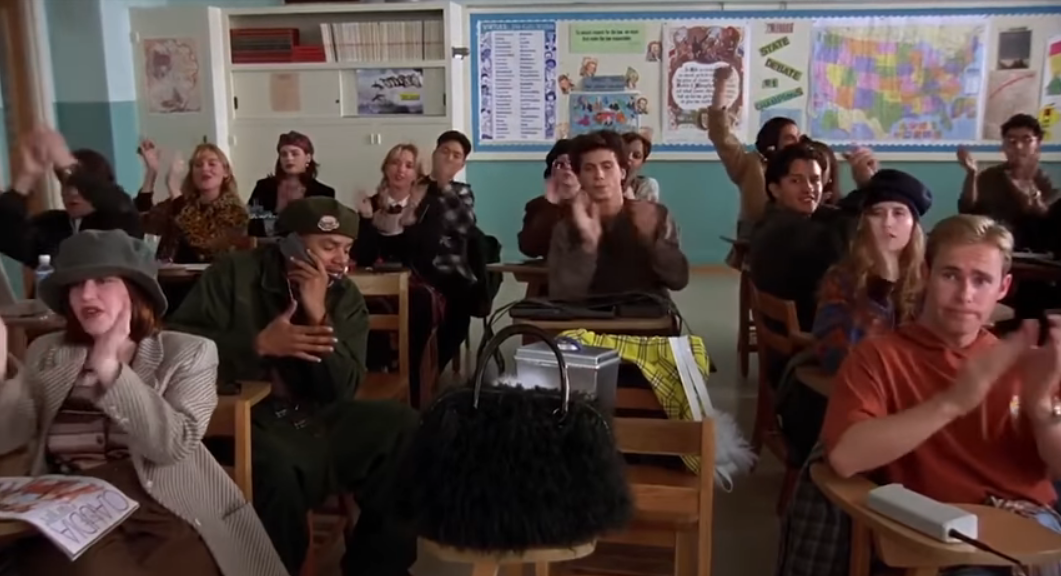For a seventeen-year-old white boy growing up in the radically multicultural suburb of Scarborough, Ontario (Canada), watching Clueless was an almost magical experience in the summer of 1995. This was the film that virtually all my crew of friends wanted to see. I first saw it with a group of female friends from my high school, one of whom I had a major crush on. Herein lay a key aspect of Clueless’s appeal; the enticing possibilities of female company—every girl wanted to see this movie—and the allure of its star, Alicia Silverstone, then Hollywood’s new “it girl.”
The movie was as popular with critics as it was with teens; writer-director Amy Heckerling won the National Society of Film Critics Award for Best Screenplay. Clueless provided a stark contrast with the other teen film in the critical spotlight that season: Larry Clark’s Kids.
While Clueless delivered its considerable wit and intelligence with a light, breezy style, Kids—a late July release—offered a dark portrait of New York City teens lost in an anomic youth culture of sex, drugs, and recklessness. The raw depictions of youth sexuality in Kids channeled the nihilism of the AIDS era; it divided critics, with many praising its cinéma vérité qualities and others condemning it as prurient and obscene (Kids notoriously received an initial NC-17 rating, though it was eventually released unrated).


Considered from the vantage of the Trump era, the naivety of Clueless’s post-racial spirit is altogether obvious. But there was also something wonderfully hopeful about it back then, especially in the long wake of racial tensions surrounding the Los Angeles riots of 1992, and the still-ongoing O.J. Simpson trial. Clueless offered a vision of racial transcendence that was mesmerizing to a cohort of teens yearning to believe that we were the generation that would rise above race. We were all as clueless as Cher, though I still take pleasure in the memory of our optimism that such a future existed—inevitably, as it then seemed—on our own horizon.
My friends and I were mesmerized, too, by Clueless’s mid-’90s “high-tech” culture: Cher’s home computer, on which she uses an avatar to select her daily attire, and the cellular phones she and her rich friends all use. A big part of Clueless’s appeal lay in its sly and playful representations of au courant popular culture, what the privileged kids of that day liked to wear, see, listen to, and consume, just as in the source text, the novel Emma (1816), Jane Austen pokes fun at the ladies of Highbury as they order fine trimmings for their “white and silver poplin” dresses and brag about the new “barouche-landau”—the Regency version of a convertible Mercedes.
I saw the film a few times that summer. On one of these occasions I met my first serious girlfriend, who was working as a part-time theatre attendant; I worked up the courage to ask for her number, which led to an intense three-year relationship and an enduring friendship.
I also saw Clueless with my friend Ian, with whom I’d seen Braveheart (Ian was a Scot by heritage, and he took great pleasure in the film), Judge Dredd, and Batman Forever. We weren’t best friends, but high school classmates who occasionally hung out and partied together, and slowly drifted apart. I studied humanities and eventually wound up in grad school, whereas Ian, ever the pragmatist, studied hotel and restaurant management and then human resources.
The last time I saw him was in the early 2000s, when we ran into one another in the local shopping mall where we’d watched Scream 2 (1997). He was there with his identical twin brother, Kyle. Ian and I remembered how much we’d enjoyed Clueless and marvelled over Alicia Silverstone that summer. We made promises to get together in the future and possibly go see some more movies.
A few years later I learned that Ian had died. He’d recently married and started a family, and was killed in a car accident while taking the backroads to work early one winter morning.
Many of my friends and acquaintances from the summer of ’95 have since passed away. Some through illnesses, some in accidents and wars, and others by the dark, anomic sex-drugs-and-alcohol side of the ’90s so evocatively captured in Kids. I can’t help but experience pangs of bittersweetness now when watching Clueless. It reminds me not just of the loss of my own friends, but also of one of the film’s stars, Brittany Murphy, who died in 2009 at just 32 due to drug complications.
Alicia Silverstone is 43 now, a vegan and animal-rights activist, recently divorced, with a nine-year-old son named Bear Blu. She has said she suffered greatly from the attention Clueless brought her, and turned away from Hollywood for years, though she eventually returned to acting. Speaking recently with the Guardian about how she learned to deal with situations of disrespect she faced in Hollywood, she said earnestly, “I always go to: there are bigger things in the world, there’s bigger tragedies.”
Despite all the layers of sadness, regret and complexity that accompany my memories of Clueless, the film’s inherent optimism still grabs me. It is filled with the promise of endless bright days ahead. I may have lost the naivety, but I haven’t lost hope.






